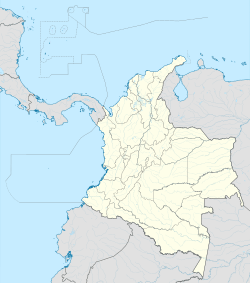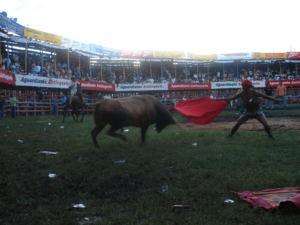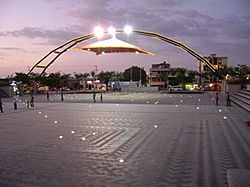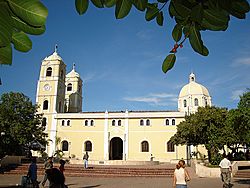Sincelejo facts for kids
Quick facts for kids
Sincelejo
|
|||
|---|---|---|---|
|
Municipality and City
|
|||
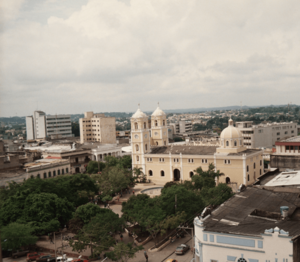 |
|||
|
|||
| Nickname(s):
La Perla de la Sabana / La Ciudad del Encuentro
|
|||
| Motto(s):
"Más Soluciones, Más Compromiso" (More Solutions, More Commitment)
|
|||
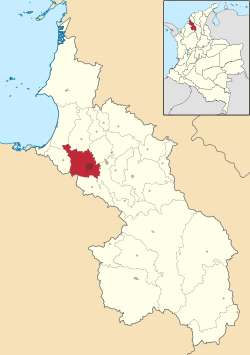
Location of the municipality and city of Sincelejo in the Department of Sucre
|
|||
| Country | |||
| Region | Caribbean Region | ||
| Department | Sucre | ||
| Established | October 4, 1535 | ||
| Founded by | Antonio de la Torre y Miranda | ||
| Government | |||
| • Type | Municipality | ||
| Area | |||
| • Municipality and City | 278.4 km2 (107.5 sq mi) | ||
| • Urban | 30.63 km2 (11.83 sq mi) | ||
| Highest elevation | 240 m (790 ft) | ||
| Lowest elevation | 180 m (590 ft) | ||
| Population
(2023)
|
|||
| • Municipality and City | 310,456 | ||
| • Density | 1,115.14/km2 (2,888.2/sq mi) | ||
| • Urban | 273,124 | ||
| • Urban density | 8,916.9/km2 (23,095/sq mi) | ||
| Demonym(s) | Sincelejano | ||
| Time zone | UTC-5 (EST) | ||
| Area code(s) | 57 + 5 | ||
Sincelejo is a lively city in Colombia, known as the capital and largest city of the Sucre region. It's located in the Caribbean region, about 30 kilometers from the Caribbean Sea. Sincelejo is also the capital of the Sabanas subregion and is one of the largest cities in Colombia by population. It's an important hub, connecting to other major cities like Cartagena and Barranquilla.
Contents
What's in a Name?
The name Sincelejo has an interesting history, and people aren't completely sure where it came from. The most popular idea is that the city was named after an important cacique (an indigenous leader) called Cincel. He was believed to be the leader of the native people who lived in this area long ago. Some old documents might support this idea, but it's still a bit of a mystery!
A Look Back in Time
Early Days and Founding
Before the Spanish arrived, the lands around Sincelejo were home to different groups of Zenú indigenous people.
The town of Sincelejo was first founded on October 4, 1535. It was given the name San Francisco de Asís de Sincelejo. This founding happened on the feast day of Francis of Assisi. The area was part of a Spanish land grant called an encomienda, where Spanish settlers managed the land and the indigenous people living there.
Rebuilding and Growth
Sincelejo was officially re-established on November 21, 1775, by a Spanish captain named Antonio de la Torre y Miranda. He was following orders from the governor of Cartagena. The town was planned with a church at its center, and land was given to people from nearby areas to help create a religious and political center. The original plan for the city was a grid shape, like many Spanish colonial towns, but local creeks made it a bit tricky to follow perfectly.
In 1812, Sincelejo became a safe place for revolutionary priests during a time of rebellion. By 1887, it was one of the biggest towns in the region. It even became the capital of its own department for a short time in 1908. In 1912, a large fire almost destroyed the center of Sincelejo, but the town was bravely rebuilt. Later, in 1966, when the Sucre Department was created, Sincelejo proudly became its capital.
Exploring the Land
Landscape and Location
Sincelejo's geography is quite interesting, with rolling hills that stretch from the mountains to the flatlands. These small hills have slopes that vary, and the land can be quite rugged in some places. The altitude in the area ranges from about 50 to 260 meters above sea level.
Sincelejo shares its borders with several other towns. To the west, you'll find Palmito and Tolú. To the south, it borders Sampués and the Córdoba Department. To the east are Corozal and Morroa, and to the north is Toluviejo.
Weather and Seasons
Sincelejo has a tropical wet and dry climate (Aw), which means it's warm all year round. The average temperature is about 27 °C (80.6 °F).
The dry season usually starts in December and lasts until the end of February. Then, the rainy season begins, with the most rain falling in April or May. There's a short period in June and July with less rain, sometimes called "Veranillo de San Juan", before the rain picks up again.
| Climate data for Sincelejo | |||||||||||||
|---|---|---|---|---|---|---|---|---|---|---|---|---|---|
| Month | Jan | Feb | Mar | Apr | May | Jun | Jul | Aug | Sep | Oct | Nov | Dec | Year |
| Mean daily maximum °C (°F) | 32.7 (90.9) |
32.8 (91.0) |
33.4 (92.1) |
32.9 (91.2) |
31.6 (88.9) |
31.1 (88.0) |
31.9 (89.4) |
31.5 (88.7) |
30.8 (87.4) |
30.5 (86.9) |
30.6 (87.1) |
31.5 (88.7) |
31.8 (89.2) |
| Daily mean °C (°F) | 26.4 (79.5) |
26.8 (80.2) |
27.5 (81.5) |
27.5 (81.5) |
27.0 (80.6) |
26.6 (79.9) |
26.7 (80.1) |
26.5 (79.7) |
26.2 (79.2) |
25.9 (78.6) |
26.0 (78.8) |
26.1 (79.0) |
26.6 (79.9) |
| Mean daily minimum °C (°F) | 20.1 (68.2) |
20.9 (69.6) |
21.6 (70.9) |
22.2 (72.0) |
22.4 (72.3) |
22.1 (71.8) |
21.6 (70.9) |
21.6 (70.9) |
21.6 (70.9) |
21.4 (70.5) |
21.4 (70.5) |
20.7 (69.3) |
21.5 (70.6) |
| Average rainfall mm (inches) | 20.4 (0.80) |
23.1 (0.91) |
21.8 (0.86) |
119.0 (4.69) |
180.0 (7.09) |
145.4 (5.72) |
124.3 (4.89) |
157.6 (6.20) |
170.2 (6.70) |
164.0 (6.46) |
103.9 (4.09) |
58.6 (2.31) |
1,288.3 (50.72) |
| Average rainy days | 3 | 3 | 4 | 9 | 14 | 12 | 11 | 15 | 14 | 13 | 10 | 5 | 113 |
| Average relative humidity (%) | 77 | 76 | 76 | 78 | 82 | 83 | 81 | 83 | 84 | 84 | 83 | 79 | 81 |
| Mean monthly sunshine hours | 234.2 | 211.8 | 199.1 | 156.8 | 141.2 | 167.1 | 199.9 | 188.4 | 144.7 | 155.7 | 164.2 | 217.0 | 2,180.1 |
How the City is Organized
Sincelejo is divided into two main parts: the urban zone (the city itself) and the rural zone (the countryside). The urban zone has 9 areas called Comunas, and the rural zone has 21 areas called Corregimientos.
Comunas
- North-east: La Selva and Villa Orieta
- West: San Carlos and Kennedy
- South-west: Pioneros and Argelia
- Central-west: Majagual and El Zumbado
- Center: La Palma and La Ford
- North: Vega and La Fé
- North-west: Margaritas and Florencia
- South: Uribe and Gran Colombia
- South-east: Verbel and El Progreso
Corregimientos
- North (Zone 1): San Rafael, La Arena, La Chivera, Las Majaguas, and La Peñata
- West (Zone 2): Las Huertas, Laguna Flor, Cerrito de la Palma, Cruz del Beque, and San Antonio
- South (Zone 3): Buenavista, Buenavistica, San Martín, San Jacinto, Cerro del Naranjo, Babilonia, Sabanas del Potreto, and La Gallera
- East (Zone 4): Las Palmas, Castañeda, and Chochó
People of Sincelejo
| Historical population | ||
|---|---|---|
| Year | Pop. | ±% |
| 1775 | 2,855 | — |
| 1852 | 6,046 | +111.8% |
| 1870 | 11,336 | +87.5% |
| 1918 | 14,722 | +29.9% |
| 1951 | 21,625 | +46.9% |
| 1964 | 44,001 | +103.5% |
| 1973 | 71,946 | +63.5% |
| 1985 | 120,537 | +67.5% |
| 1993 | 168,410 | +39.7% |
| 2005 | 237,639 | +41.1% |
| 2018 | 277,773 | +16.9% |
| 2023 | 310,456 | +11.8% |
| Source: DANE | ||
In 2023, Sincelejo had a population of over 310,000 people. Most of the people identify as White, Arab, or Mestizo (a mix of European and indigenous heritage). A smaller part of the population identifies as Indigenous people or Afro-Colombian.
How Sincelejo Makes Money
The economy of Sincelejo mainly relies on farming, raising animals, and trade. The biggest part of the economy is the livestock sector, especially raising cattle for beef. Sincelejo is even called the "Zebu Capital of Colombia" because of its famous beef cattle. Dairy farming is also important, but beef cattle are the main focus.
Agriculture is the second largest part of the economy. Farmers in Sincelejo grow crops like maize (corn), cassava, yams, and bananas.
Besides farming and livestock, trade, government jobs, and other services also help the city's economy. New factories are starting to appear, making things like drinks, starch, clothes, shoes, and building materials. There are about 3000 businesses in the city, showing how busy its economy is!
Culture and Fun
Music and Food
Sincelejo has a rich culture, especially when it comes to music. Traditional music styles include the Porro, Fandango, and Vallenato.
When it comes to food, the traditional dish of Sincelejo is mote de queso, which is a delicious soup made with cheese.
Handicrafts
The city is also known for its beautiful handicrafts made by local people. These include colorful hammocks and the famous sombrero vueltiao. The sombrero vueltiao is a special hat that has even become a national symbol of Colombia!
Festivals and Celebrations
Sincelejo hosts many fun cultural festivals every year:
- The Fiestas del dulce nombre de Jesús (Celebrations of the Sweet Name of Jesus)
- The Encuentro Nacional de Bandas (National Meeting of Bands)
- The Festival Sabanero del Accordeón (Savanna's Accordion Festival)
The Encuentro Nacional de Bandas is a music competition where folk bands play traditional music styles like Porro and Fandango. This event has been happening every year since 1984. The Festival Sabanero del Accordeón, which started in 1974, celebrates accordion music from the region, including styles like Paseo, Merengue, Vallenato, and Puya.
The Corraleja Festival
Sincelejo is especially famous for its annual festival called Fiestas del dulce nombre de Jesús, held every year on January 20. This festival lasts for several days and includes exciting parades, a beauty contest, and traditional bullfighting events.
Because of the bullfighting, the festival is also known as Las Fiestas de Corraleja. This name comes from the temporary wooden bullring built for the event, called a corraleja. In 1980, a sad event happened when the wooden stands of the bullring collapsed, causing many injuries and some deaths. After this, the Corraleja part of the festival was stopped for several years.
In 1999, the city decided to allow the building of the wooden bullring again, bringing back the bullfighting tradition. Today, civil engineers and architects help supervise the construction of the temporary bullring to make sure it is safe.
The bullfighting usually takes place over several days, with different cattle farms bringing bulls each day. On the last day, the farm with the best performance gets a special reward. People who enter the ring to participate don't get an official prize, but sometimes wealthy landowners offer unofficial money to encourage them.
It's important to know that some people have concerns about the festival, especially regarding how the animals are treated.
Places to See
Majagual Plaza: This plaza is often called La Placita de Majagual (The Little Plaza of Majagual). It's been mentioned in many folk songs! For many years, this plaza was where the corralejas (bullfighting events) were held, but now it's used for sports and other activities. In 2007, the plaza was updated with a modern design, including a cool arch sculpture and a big open space for cultural events.
Santander Park: Santander Park opened in 1776, around the same time the city was formally established. It was the first place where the corralejas were held in the city, from 1845 until 1964.
Saint Francis of Assisi Cathedral: The Catedral San Francisco de Asís was built in 1853 and is right next to Santander Park. It's a very important place for religious celebrations and festivals in Sincelejo, including the Fiestas del Dulce Nombre de Jesús. It's also the main church for the Roman Catholic Diocese of Sincelejo.
Sincelejo's Municipality Theater: This theater opened in 1997. It's a great place to see concerts, musicals, folk events, and even operas!
VIVA Sincelejo Shopping Center: The VIVA Sincelejo Shopping Center opened in 2006. It was first called Saint Francisco Shopping Center. In 2011, a new, bigger mall was built in the same spot, and now it has about 91 different shops!
How the City Works
Media and News
Sincelejo has two local daily newspapers: El Meridiano de Sucre and El Universal Sincelejo. You can also find regional and national newspapers like El Tiempo and El Espectador.
There are many radio stations, including local ones and bigger national stations like RCN Radio and Caracol Radio. Sincelejo also receives five national television channels. There are also cable TV services, and one of them, Claro, has a local TV channel called Canal Doce (Channel 12) that focuses on news and programs about Sincelejo.
Getting Around
Sincelejo is a very important crossroads on Colombia's Caribbean coast. It's close to many other important towns and cities like Montería, Magangué, Coveñas, San Marcos, Barranquilla, Cartagena, and Medellín. You can easily travel to these places by bus or taxi.
About 15 kilometers from Sincelejo is Las Brujas Airport. From here, you can catch daily flights to major cities like Bogotá and Medellín.
Learning and Education
As the main city in the Sucre region, Sincelejo has many students. There are 35 public schools and several private schools. The only public university in Sucre, Universidad de Sucre, is located in Sincelejo.
There are also several private universities, such as CECAR and Universidad San Martín. For those interested in technical training, SENA is a very important institution. Sincelejo also has places dedicated to cultural education, like La Escuela de Bellas Artes (School of Fine Art).
Images for kids
Famous People from Sincelejo
- Jorge Alfaro, a professional baseball player.
- Ariadna Gutiérrez, a famous model and beauty pageant winner.
- Verónica Alcocer, the First Lady of Colombia.
See also
 In Spanish: Sincelejo para niños
In Spanish: Sincelejo para niños




